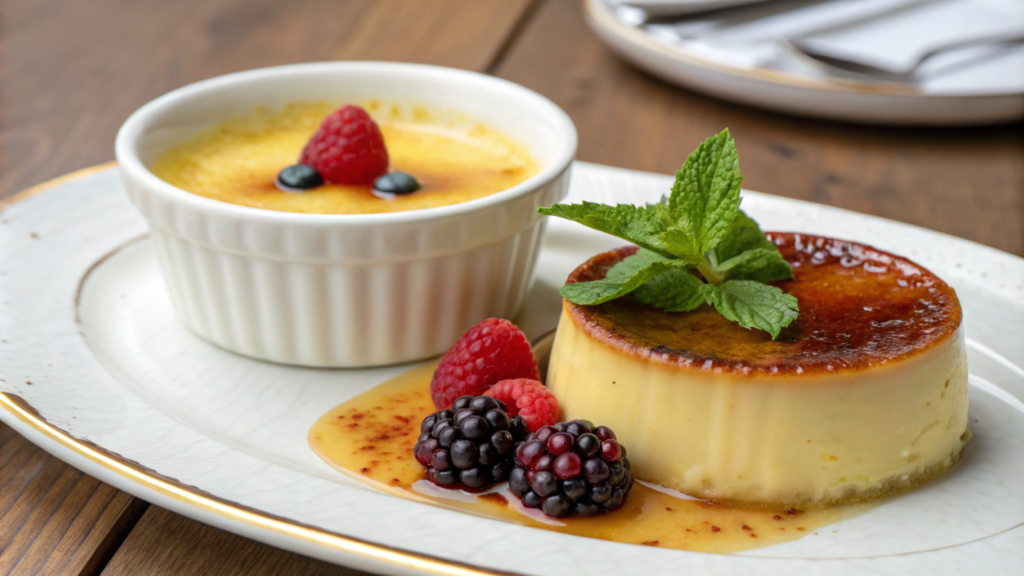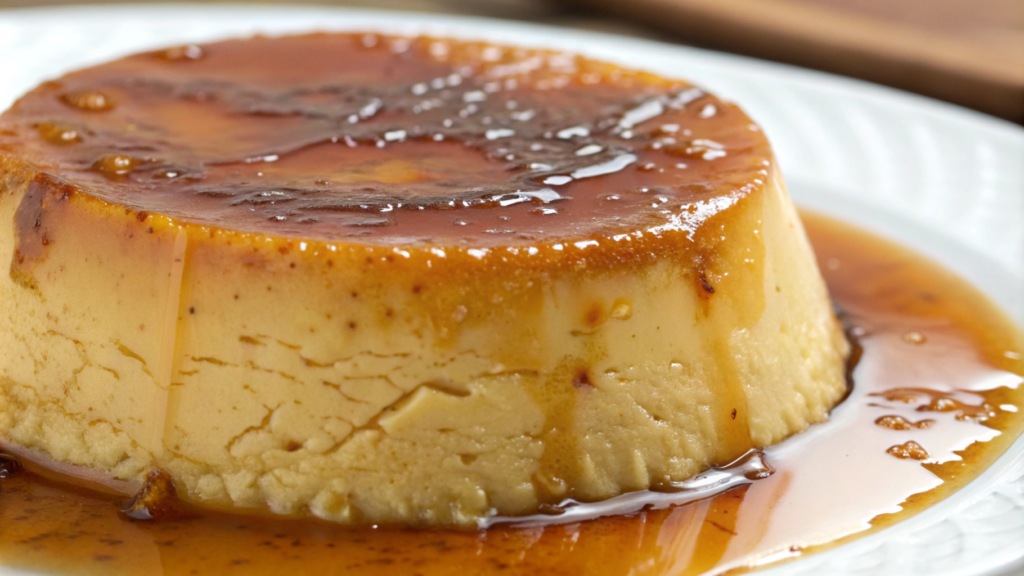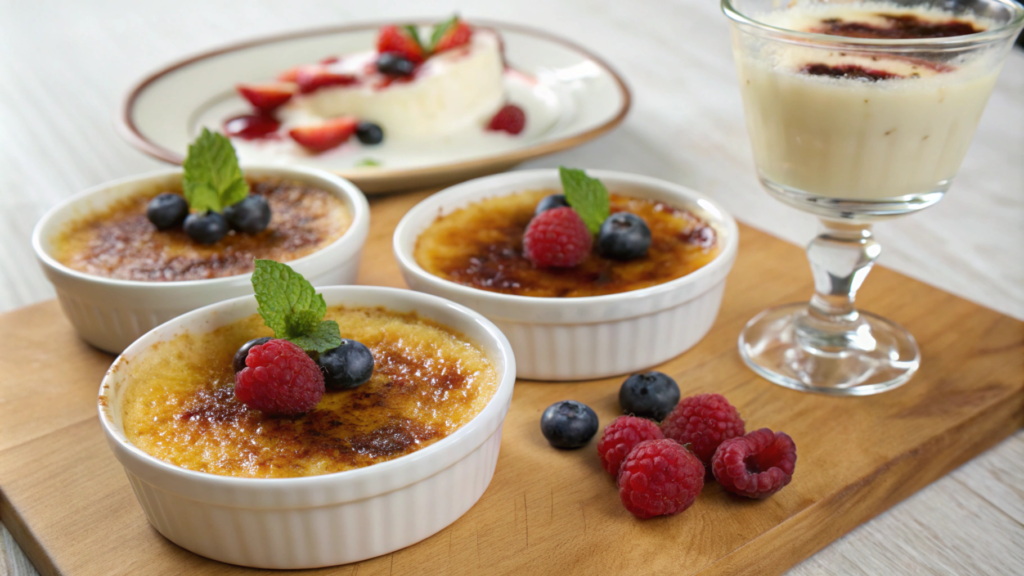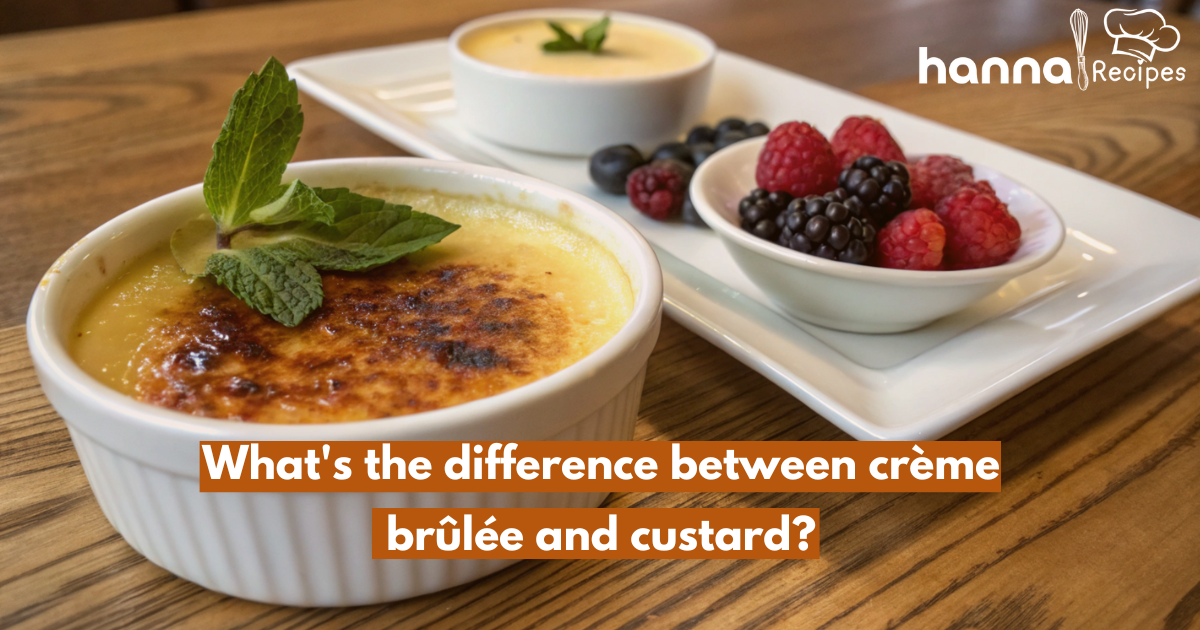In the world of desserts, crème brûlée and custard are two favorites from French cuisine. They both use eggs and are loved for their creamy texture and tasty flavors. But, they differ in their history, how they’re made, and what they taste like.
Learning about the differences between crème brûlée and custard can make us appreciate these desserts even more.

Key Takeaways
- Crème brûlée and custard have distinct origins and culinary histories, with crème brûlée rooted in French tradition and custard having a more widespread global appeal.
- The key structural difference lies in the caramelized top that defines crème brûlée, which is achieved through a unique baking process.
- Texture and consistency play a crucial role, with crème brûlée boasting a silkier, richer mouthfeel compared to the smoother, creamier custard.
- Serving temperature is another distinguishing factor, with crème brûlée typically served chilled, while custard can be enjoyed warm or at room temperature.
- Flavor profiles and variations offer a wide range of options, allowing both desserts to be customized to individual preferences.
Understanding the Origins: French Custard vs Traditional Custard
Crème brûlée, a beloved French dessert, comes from France’s rich culinary history. It has won the hearts of dessert lovers everywhere. While it’s closely tied to French cuisine, custard has also spread globally, leaving its mark in many places.
The French Culinary Heritage of Crème Brûlée
The story of crème brûlée starts in the 17th century in France. It was called “burnt cream” back then. The first recipe was in François Massialot’s “Cuisinier royal et bourgeois” in 1691. Since then, chefs have kept improving it, trying new flavors and methods.
Evolution of Classic Custard Through History
Crème brûlée is a significant part of French cooking, while custard’s history dates back much further. In fact, it was enjoyed by ancient Romans and Chinese dynasties as well. Over time, custard has evolved, influenced by local ingredients and cooking styles. Today, it is loved all over the world, showcasing its lasting charm.
| French Custard (Crème Brûlée) | Traditional Custard |
|---|---|
| Originated in 17th century France | Traced back to ancient civilizations |
| Characterized by a caramelized top | Diverse variations across cultures |
| Considered an iconic French dessert | Widely enjoyed in various regions |
“The history of crème brûlée is a testament to the enduring allure of French culinary excellence.”
Basic Components and Ingredients: A Detailed Breakdown
Crème brûlée and custard both rely on eggs for their creamy texture. They also share a love for vanilla flavors, which add a comforting aroma. These ingredients are the heart of these desserts.
But, there’s a difference in the custard ingredients used. Crème brûlée has a simple mix of eggs, cream, and sugar. Custard, on the other hand, might include milk, cornstarch, or flour for a thicker texture.
| Ingredient | Crème Brûlée | Custard |
|---|---|---|
| Eggs | ✓ | ✓ |
| Cream | ✓ | |
| Milk | ✓ | |
| Sugar | ✓ | ✓ |
| Vanilla | ✓ | ✓ |
| Cornstarch/Flour | ✓ |
The quality of the ingredients is key. Using the best eggs and vanilla flavors makes a big difference. With the right mix, both crème brûlée and custard can be truly exceptional.
Crème brûlée’s distinctive feature is its caramelized sugar crust, which gives it a delightful crunch. For more adventurous variations, consider trying recipes like the decadent Crab brûlée recipe.
What’s the Difference Between Crème Brûlée and Custard?
Crème brûlée and custard are often discussed together, but they are not the same. In fact, they have distinct textures and tastes. Let’s explore what makes each of them unique.
Key Structural Differences
Crème brûlée starts with a creamy custard base. It’s made with egg yolks, cream, and sugar. Custard, on the other hand, is softer and made with more milk. It has a silkier texture.
Texture and Consistency Variations
Crème brûlée is thick and smooth, with a slight jiggle. Custard is lighter, like a pudding. Both are delicious but feel different in your mouth.
Serving Temperature Distinctions
How you serve them also differs. Crème brûlée is chilled, with a caramelized top. Custard is best at room temperature or slightly warm. This lets its flavors and texture stand out.
Whether you prefer the rich crème brûlée or the smooth custard, knowing the differences helps. It makes choosing a dessert a more enjoyable experience.
The Signature Caramelized Top: Crème Brûlée’s Distinct Feature
Crème brûlée is famous for its caramelized sugar topping. This thin, crisp layer beautifully contrasts with the smooth custard beneath. In fact, getting the caramelized sugar just right is truly an art.
To make this topping, a thin layer of sugar is sprinkled over the custard. Then, it’s caramelized with a torch or broiler. This turns it into a golden, crisp layer that shatters with each bite. It’s all about controlling the temperature and timing to avoid burning the custard.
Unlike traditional custards like crème pâtissière or pastry cream, crème brûlée has a unique topping. The caramelized sugar topping gives it a special texture. This makes crème brûlée a standout dessert.
“The caramelized sugar topping is the hallmark of crème brûlée, adding a satisfying crunch that complements the creamy custard beneath.”
For those who love crème brûlée, mastering the caramelized topping is essential. It involves finding the perfect balance between a delicate custard and a crisp, golden sugar crust. As a result, this combination transforms the dessert into a true delight for the senses.

Preparation Methods and Cooking Techniques
Creating the perfect baked custard or crème brûlée is truly an art. It requires a deep understanding of both the preparation methods and cooking techniques. Specifically, from using the water bath for baking to carefully controlling temperature and timing, every step plays a crucial role in achieving the desired result.
Water Bath Baking Process
The water bath, or bain-marie, method is crucial when making baked custard and crème brûlée. Essentially, it involves placing the custard-filled ramekins in a pan of hot water. As a result, this method ensures the custard cooks evenly, preventing it from cracking or overcooking.
Temperature Control and Timing
Getting the temperature and timing right is essential for a perfect baked custard and crème brûlée. For instance, the custard must be heated to the ideal temperature to achieve a smooth texture. Additionally, the caramelized top of crème brûlée requires precise cooking and broiling times to achieve the perfect finish.
Achieving the Perfect Crack
The caramelized top of crème brûlée is truly a highlight. After baking, the custard is chilled, and a thin layer of sugar is sprinkled on top. Then, using a kitchen torch or broiler, the sugar is carefully caramelized. As a result, this creates the signature brittle, crackly surface that contrasts beautifully with the creamy custard beneath.
By mastering these cooking techniques, you can significantly improve your dessert preparation. As a result, you’ll be able to create truly exceptional baked custards and crème brûlées.
Flavor Profiles and Variations in Both Desserts
Both crème brûlée and custard start with a common base: vanilla flavors. This classic taste gives them a rich, creamy feel. It also complements their unique textures perfectly.
But there’s more to these desserts than just vanilla. In fact, crème brûlée and custard offer a wide range of custard varieties and dessert flavors. For example, you can mix chocolate and coffee for a rich, indulgent taste, or experiment with citrus and berries for a refreshing twist.
The caramelized crust of crème brûlée is ideal for enhancing flavors. For instance, you can add lavender, earl grey, cinnamon, or nutmeg. These flavors blend seamlessly with the custard, making it a delightful treat to enjoy.
On the other hand, traditional custard is renowned for its smooth and creamy texture. In addition, it serves as an excellent base for experimenting with a variety of vanilla and dessert flavors. For example, by adding lemon, raspberry, mango, chocolate, or caramel, you can completely transform its taste.
Both crème brûlée and custard are amazing in their own ways. They can surprise your taste buds with their balanced flavors. Whether you like classic vanilla or want to try something new, these desserts have something for everyone.
Common Mistakes in Making Both Desserts
Making the perfect crème brûlée or custard requires careful technique and attention to detail. Moreover, even skilled chefs can encounter common problems along the way. Therefore, let’s take a closer look at these issues and explore effective solutions to ensure great results.
Temperature Control Issues
Getting the right temperature is crucial for achieving the perfect texture in crème brûlée and custard. If it’s too hot, the texture can become grainy, while if it’s too cold, it may turn runny. Therefore, here’s how to effectively control the temperature:
- Use a reliable oven thermometer to check your oven’s temperature.
- Check the custard’s internal temperature and take it out when it’s just right.
- Adjust the water bath’s temperature and cooking time for the best crème brûlée or custard.
Texture Problems and Solutions
Getting the right texture is crucial for both crème brûlée and custard. Issues like grainy, lumpy, or watery textures can happen. Here’s how to fix them:
- Make sure all ingredients are at room temperature before starting.
- Whisk or blend the custard base carefully to avoid air bubbles and get a smooth texture.
- Use a water bath to bake the custard gently and prevent curdling.
- Play with the egg, cream, and milk ratios to find the perfect texture for your baked custard.
Mastering temperature control and addressing texture issues can significantly improve your crème and custard cooking techniques. As a result, you’ll be able to achieve consistently delicious desserts.
Serving Suggestions and Presentation Tips
Desserts like crème brûlée and custard shine when presented well. Creative garnishes and the right temperature can make a big difference. These details can turn a simple dessert into a memorable experience.
Crème brûlée is all about the caramelized top. Serve it in ramekins so everyone can enjoy the golden crust. Add fresh berries, a sprinkle of cinnamon, or caramel sauce to enhance the flavor.
Custard is best chilled to show off its silky texture. Use glass dishes or small bowls and top with fruit compote or toasted nuts. This makes the dessert even more appealing.
| Dessert | Serving Suggestions | Garnishes and Accompaniments |
|---|---|---|
| Crème Brûlée | Serve in individual ramekins | Fresh berries, cinnamon, caramel sauce |
| Custard | Serve chilled in glass dishes or small bowls | Fruit compote, toasted nuts |
Creating a beautiful presentation is essential for any dessert. In fact, it should complement the flavors and textures of the custard varieties. Furthermore, with a bit of creativity, you can transform these classic desserts into something truly unforgettable.

FAQ
What’s the difference between crème brûlée and custard?
Crème brûlée and custard differ mainly in texture and preparation. Crème brûlée has a creamy base topped with caramelized sugar. Custard, on the other hand, is smooth and silky without the caramelized shell.
What are the origins of crème brûlée and classic custard?
Crème brûlée has its origins in French cooking, dating back to the 17th century. In contrast, custard’s history spans various cultures, with egg-based desserts evolving and adapting over time.
What are the key ingredients in crème brûlée and custard?
Both desserts use eggs and vanilla for their creamy flavors. But, they have different ingredient ratios and preparation methods.
How do the textures and consistencies of crème brûlée and custard differ?
Crème brûlée is dense and creamy, with a crunchy caramel top, while custard remains smooth and silky throughout. Moreover, the preparation and serving methods significantly shape their textures.
What makes the caramelized top of crème brûlée so unique?
The caramelized sugar on crème brûlée is created by melting sugar with a torch or broiler. As a result, this process forms a crunchy top that beautifully contrasts with the smooth custard beneath.
What are some common mistakes in making crème brûlée and custard?
Mistakes often come from temperature control and getting the right consistency. Also, caramelizing the top can be tricky. Paying close attention to detail is key.
How can crème brûlée and custard be served and presented?
You can serve both desserts in a variety of creative ways. For instance, using garnishes and accompaniments can enhance the overall experience. Additionally, serving them at the right temperature and with an elegant presentation is equally important.
Conclusion
The crème brûlée and the classic custard are both egg-based desserts. They have different origins and unique qualities. Even though they share a similar base, they stand out in the world of French cuisine.
The caramelized top and silky texture of crème brûlée make it a sophisticated treat. It shows off French culinary skills. Meanwhile, traditional custard is loved for its creamy texture and familiar taste.
Whether you like the drama of crème or the comfort of custard, these egg-based desserts are a journey through French culinary history. Enjoying each spoonful, you’ll appreciate the differences that make what’s the difference between crème brûlée and custard? so interesting.


1 thought on “What’s the difference between crème brûlée and custard?”